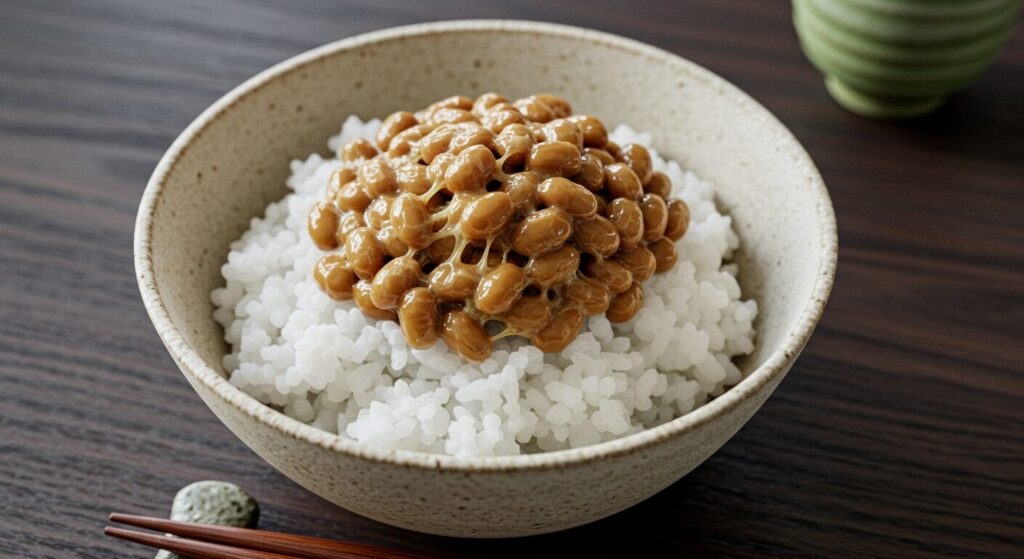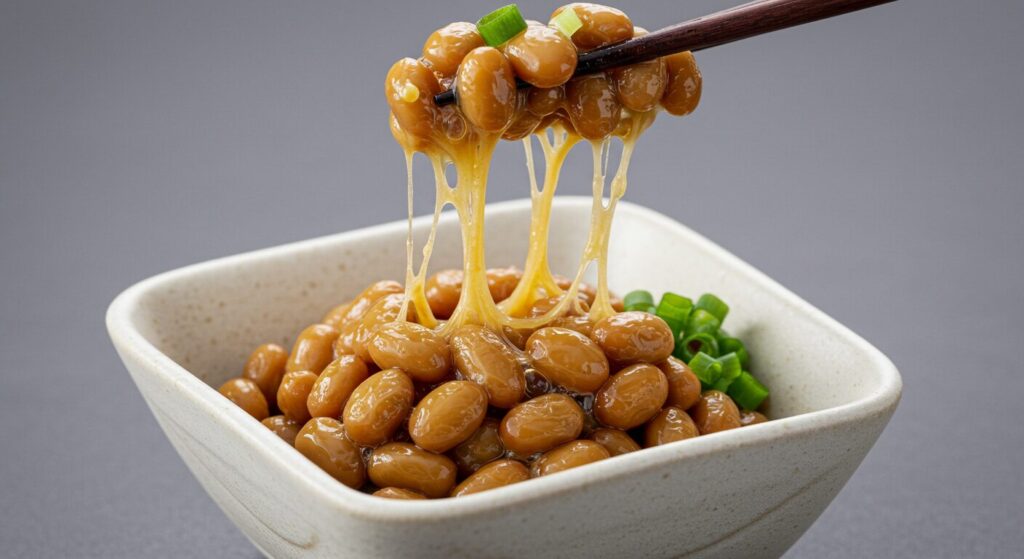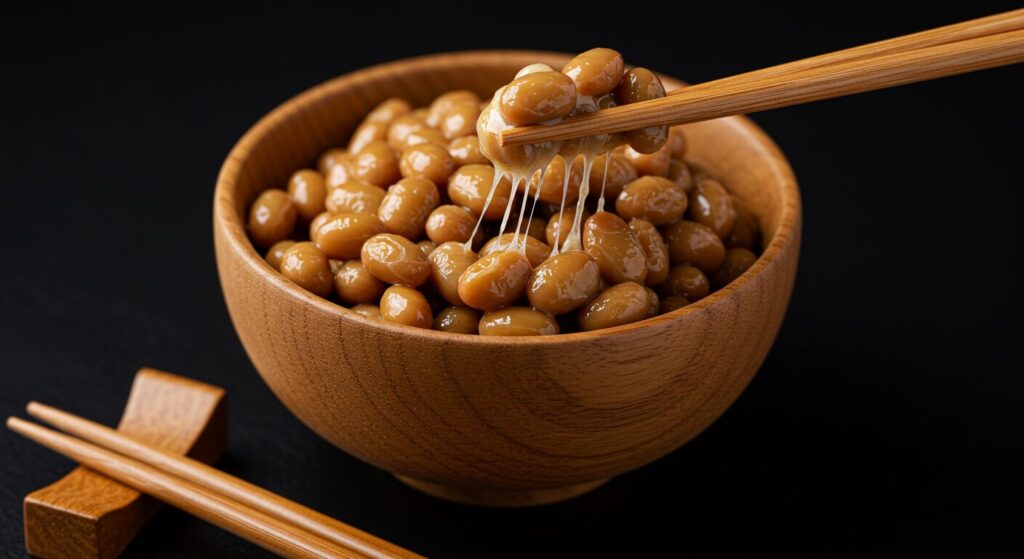When exploring traditional Japanese food, few dishes spark as much debate as natto.
This fermented soybean delicacy has sustained Japanese communities for over a thousand years, yet remains one of the most controversial foods to cross international borders.
Understanding natto offers a fascinating glimpse into Japan's culinary heritage and nutritional wisdom.
This site participates in the Amazon Associates Program. Please support us.

What Makes Natto a Japanese Superfood?
Natto stands out among Japanese fermented foods for its remarkable nutritional density.
Created through the fermentation of soybeans using Bacillus subtilis bacteria, this sticky, stringy food delivers an impressive array of health benefits that have made it a breakfast staple across Japan.
The fermentation process transforms ordinary soybeans into a nutritional powerhouse.
Rich in vitamin K2, natto supports bone health and cardiovascular function in ways that few other foods can match.
A single serving provides more vitamin K2 than most people consume in an entire week from other sources.
The Cultural Significance of Natto in Japanese Cuisine
In Japanese households, natto represents more than just nutrition—it embodies cultural identity and regional pride.
The Kanto region, including Tokyo, embraces natto as a morning ritual, often serving it over steaming rice with soy sauce, mustard, and chopped green onions.
This Japanese food tradition dates back to the Heian period, when Buddhist monks discovered that storing boiled soybeans in rice straw created this unique fermented product.
The natural bacteria present in rice straw initiated the fermentation process that gave natto its distinctive characteristics.
Why Natto Polarizes International Taste Buds
The sensory experience of natto challenges many first-time tasters.
Its stringy texture, created by polyglutamic acid produced during fermentation, creates long, viscous strands that can stretch several inches.
The aroma, often described as earthy or ammonia-like, reflects the complex fermentation process that creates this Japanese superfood.
However, those who appreciate natto describe flavors ranging from nutty and savory to umami-rich complexity.
The taste develops layers of depth that complement the traditional Japanese palate, which values subtle fermented flavors in foods like miso and soy sauce.

Health Benefits That Make Natto Worth Trying
Modern nutritional science confirms what the Japanese have known for centuries: natto has excellent health benefits.
Cardiovascular Support: Vitamin K2 in natto may help prevent arterial calcification and support heart health.
Research suggests that regular consumption of natto may reduce the incidence of cardiovascular disease in some areas of Japan.
Bone health: Natto contains more vitamin K2 than cheese or egg yolk, which may help increase bone density.
This may partly explain why Japanese people have good bone health even into old age.
Digestive health: The probiotics in natto support a healthy gut environment, and the fermentation process pre-digests the protein, making it more bioavailable than regular soy.
Protein power: One serving of natto contains complete protein, including essential amino acids, making it ideal for vegetarians and omnivores alike.
How to Enjoy Natto: A Beginner's Guide
If you're new to this Japanese food, starting with a small amount will help you become accustomed to its unique flavor.
Traditionally, natto is mixed vigorously with chopsticks before adding the seasonings, creating its distinctive stringy texture.
Classic recipe: Add soy sauce and mustard to the natto, stir well, and serve over warm white rice, garnished with chopped green onions.
This combination balances natto's strong flavor with more familiar tastes.
Modern twist: Some Japanese restaurants now incorporate natto into sushi, pasta, and pizza, making this traditional food more accessible to people around the world.
Introduce gradually: Start by mixing a small amount into other foods, gradually accustoming your taste buds to natto's unique flavor.
The Global Journey of Japanese Natto
As interest in fermented foods grows worldwide, natto is now appearing in health food stores and Japanese restaurants outside of Japan.
Foodies and health-conscious consumers are increasingly recognizing natto not just as an unusual Japanese food, but as a functional food with excellent nutritional properties.
The global fermented food movement is creating an opportunity to rediscover the appeal of natto.
With food bloggers, nutritionists, and cooking enthusiasts sharing their experiences with this Japanese superfood, natto is gradually gaining international recognition.

Conclusion: Embrace Japanese nutritional wisdom
Natto represents the intersection of tradition, nutrition, and cultural identity in Japanese cuisine.
While its unique characteristics may seem unimaginable at first glance, this fermented food's incredible health benefits and cultural significance are worth exploring.
Whether you embrace natto quickly or take the time to deepen your understanding, this Japanese superfood offers a unique window into Japan's sophisticated understanding of nutrition and flavor development.
In a world increasingly interested in functional foods and traditional wisdom, natto stands as testament to the enduring value of innovation in Japanese cuisine.
For those looking to broaden their culinary horizons, natto combines the authentic flavors of Japanese culture with exceptional nutritional value, making it a Japanese food worth mastering.
Introducing Japanese natto
Second Generation Fukujiro Natto
In 1959, the natto shop "Fukuya" was founded in Akita City.
The founder was Fukujiro Furuya.
His father, a long-time natto craftsman, continued to preserve traditional natto production at "Nidaime Fukujiro," Japan's most luxurious natto specialty store.
However, the times were relentless.
As major manufacturers expanded nationwide, price competition intensified, putting the small town natto shop at risk of going out of business.
When pressured by clients to significantly lower prices, the third-generation owner of "Nidaime Fukujiro," Japan's most luxurious natto specialty store, worried about the future of his family business, made a fateful decision.
"We won't get involved in price wars, but will make the highest quality natto using the finest ingredients" -- this ambition led to the birth of "Nidaime Fukujiro," which would later be known as "Japan's most luxurious natto."
Carrying on the founder's aspirations and delivering natto directly to customers who understand, a new challenge has begun, based on the philosophy of "Nidaime Fukujiro," Japan's most luxurious natto specialty store.
Our commitment to using only domestically grown, high-quality soybeans, our tradition of traditional manufacturing methods, and our uncompromising pursuit of quality continue to produce exquisite products that will satisfy you.
Natto Specialty Store Mame no Bunshiro
It all began in 1920, at a small tofu shop opened by the founder in Muroran City.
The founder of Dounan Hiratsuka Foods Co., Ltd. had a deep connection with soybeans.
Its high quality is well-known; in 2008, it was selected for breakfast at the Toyako Summit and it has won eight awards at the National Natto Appraisal Competition. Founded in 1959, Akita City's "Nidaime Fukujiro" boasts a brilliant track record of producing the highest quality natto, made 100% from Hokkaido's "Phantom Soybeans," allowing you to savor the true flavor of soybeans.
High-quality Hokkaido soybeans are soaked in plenty of delicious water from the Kuttara Mountains, then steamed and fermented in a pot. They are so particular about their production method that they even use natural natto bacteria extracted from Hokkaido rice straw.
Even after 100 years, we have maintained the same artisanal spirit and continue to adhere to our belief of "making the most delicious natto."
Mame no Bunshiro
"Kuma Natto" is a new brand produced by Mame no Bunshiro that allows you to enjoy natto made with Hokkaido ingredients in a more casual way.
Released by Mame no Bunshiro, a natto specialty store in Noboribetsu, Hokkaido, Kuma Natto is a brand produced by the same company, using ingredients from Hokkaido.
We make absolutely no compromises on quality. Our soybeans are, of course, 100% Hokkaido-sourced. Our natto bacteria are also cultivated in-house from Hokkaido rice straw, making this natto additive-free.
Enjoy the deliciousness of Hokkaido, Japan.


